Next Steps for Great Island
By Pamela Dey Vossler
photos by: Bambi Riegel riegelpictureworks.com
Thank you Palmer’s Market for sponsoring our cover feature.
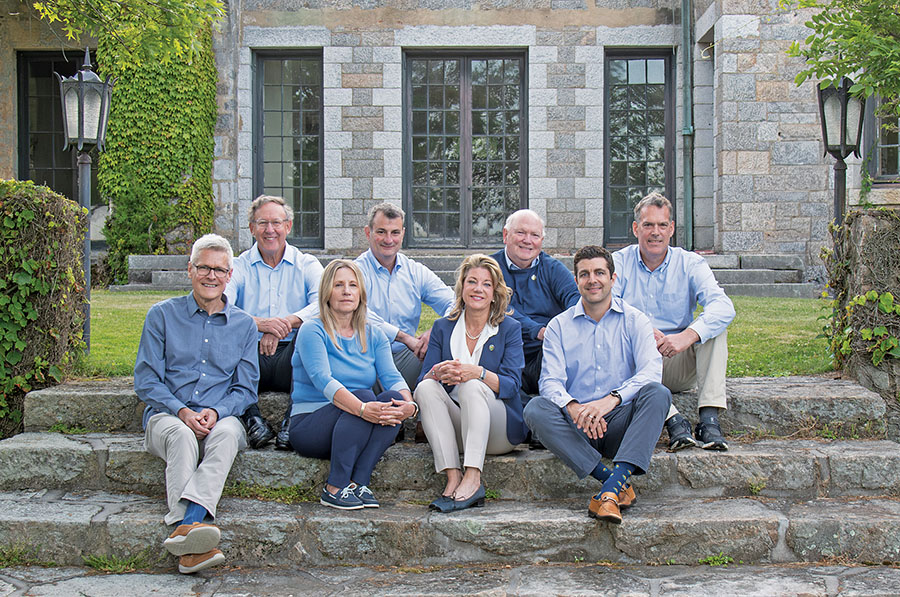
GIAC members in front of the Gilded Age mansion on Great Island. front (from left): Jeff Taebel, Lori Bora, Monica McNally, Kipp Visi, back (from left): Dan Kolakowski, Mark Adiletta, Mike Burke, Bruce Ferguson, not pictured: Jim Palen
“There will never be ‘the right time’ in your life to do a great thing. You must create that time and greatness will follow.” The author John A. Passaro wrote that. He could very well have been talking about Great Island, the 60-acre property opposite Ring’s End Bridge the town purchased in May ’23 from Ned Steinkraus and his siblings. They are the most recent descendants of the family that has owned it since 1902.
It was a generational opportunity requiring a breathtaking boldness not often found in municipal government—a confidence born of the kind of certainty possessed by people who see beyond their lifetimes to deliver what we often come to value most.
Though the purchase was widely supported, it was Monica McNally who grabbed hold of the idea to secure Great Island for the town while First Selectman in 2022. With Darien’s ongoing commitment to acquiring open space, as outlined in the 2016 Town Plan of Conservation and Development and the Parks and Recreation Master Plan, it had come up before. But in 2016, when the family first put it on the market for $175 million, the price was too high. By 2022, the price had dropped to $100 million and Monica was sitting on the steps of Ned’s home on Brookside Road, talking to his dog while waiting for him to return so that she could ask him to extend the offer deadline to give the town a chance to get in on the bidding.
“When I heard about it, there wasn’t a lot of time to respond,” explained Monica who credits the Board of Selectmen, Board of Finance Chair Jim Palen and the Representative Town Meeting (RTM) for championing the idea with her and speeding the process to purchase. Usually these types of things take many, many months to make their way through our system of governance. For Great Island, from offer to an accepted bid of $103 million, it was just two months.
Then came nearly a year of due diligence and a sharpening of pencils that brought the price to a final $85 million—testimony to the meticulous care paid by our elected town leaders to the spending of public money.
“It was a big decision to acquire Great Island. Even bigger was the effort to negotiate the acquisition, expertly led by Monica McNally and Jim Palen,” said First Selectman Jon Zagrodzky. “I believe the result has been well worth the effort. We have an incredible property that residents will be able to enjoy in so many ways.”
And when you add open space to a town, as this does, property values rise in general, according to Monica, which benefits owners when they eventually sell. But the costs associated with Great Island will add to the tax burden.
“Yes, the debt associated with the project will have annual carrying costs, but not so much that they impair our ability to fund our other spending priorities,” Jon said. “To be clear, we remain committed to having the very best schools, parks, roads, police and fire protection and other important services. We can maintain this excellence while still working to make Great Island the finest municipal property on the East Coast,” he continued.
Coupled with the transparency and detailed communication with all town decision makers that marked every step of the process, the sale was finalized in May 2023.
When you see Great Island, you will understand our effusion: You will be blown away. We can just about guarantee it.
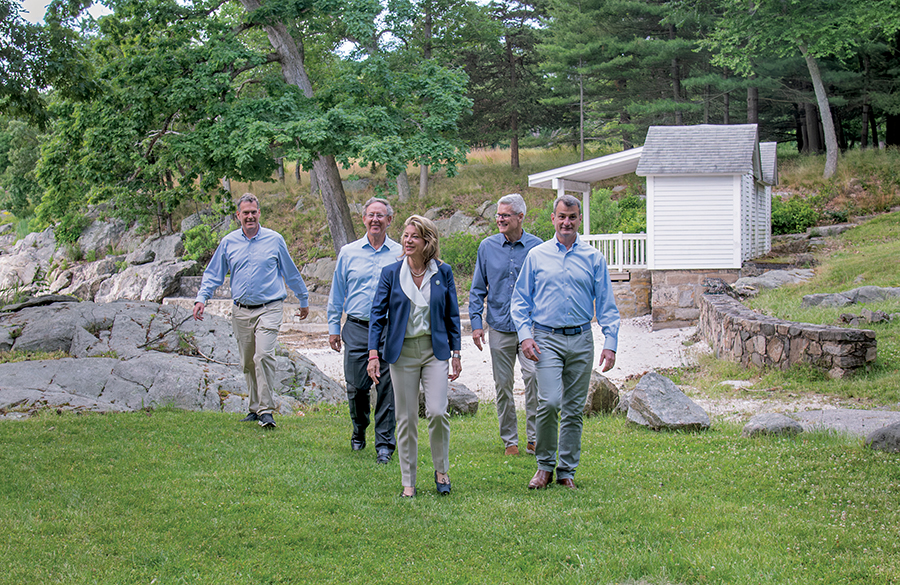
GIAC members, from left: Bruce Ferguson, Dan Kolakowski, Monica McNally, Jeff Taebel, Mark Adiletta with Great Island bathhouses in background
“The property is just so special. On every visit I become more excited about the possibilities and feel gratitude just to be able to enjoy its majesty,” said Parks and Recreation Commission Chair Lori Bora.
If you’ve been there since it opened to pedestrians in March, you already know Great Island is that… well …THAT …you fill in the superlative. It’s what you’ll be asked to do starting this September as part of next steps for it. That’s when outreach for public input begins, led by Reed Hilderbrand, the landscape design company the town chose in June to help us map out what we will do with this extraordinary tract. (If your jaw hits the ground when you walk Great Island, prepare to keep it there when you see the firm’s portfolio—a showcase of their experience balancing preservation of historic structures with environmental conservation while accommodating new community activities and factoring in everything from the magnificent to the mundane including bathrooms, signage and a place to wash your hands and more.)
Everyone will have a chance, many chances in fact, to weigh in on what we hope for Great Island—online, in public forums, in workshops and other ways yet to be determined. Because, despite the conjecture and possibilities you may have heard tossed around for this great space, no decisions have been made about what will happen there, beyond steps taken to open the Island to residents and widen the road leading on to the property which will occur later this fall.
“The important thing to know is that it’s a clean slate,” said Monica, now chair of the Great Island Advisory Committee (GIAC), the nine-member group authorized by the town last summer to prepare the property for public access and create a usage plan.
GIAC is comprised of five elected members of town government including Monica who gave up her post as First Selectman to lead GIAC though she remains on Darien’s Board of Selectman. The other four are Jim Palen, Lori Bora, Selectman Mike Burke and RTM member Mark Adiletta who is also GIAC Vice Chair. The four resident members of GIAC chosen last fall from 45 applicants are Daniel Kolakowski who spent his career in construction management, working on projects including the Hudson River Park Trust, the new LaGuardia Airport and the Brooklyn Bridge Park Corp., Bruce Ferguson, a software CEO who serves on the board of the Darien Athletic Foundation and is a past president of the Darien Library Board, Kipp Visi who brings a deep background in financial management and reporting, and Jeff Taebel who served as the Houston-Galveston Area Council’s director of community and environmental planning for 35 years before moving to Darien in 2022 to be closer to his grandchildren.
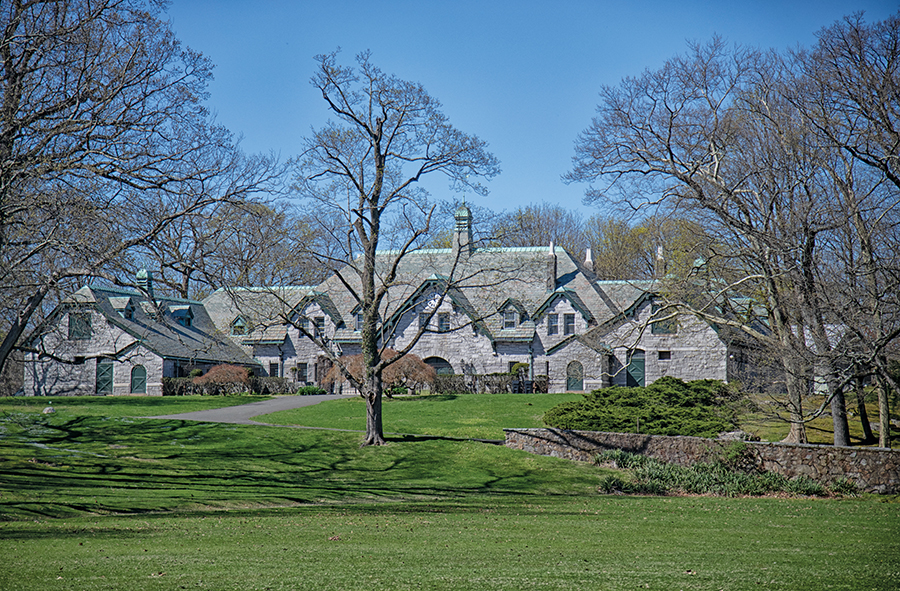
Great Island equestrian complex
It is an all-star, all-volunteer group that has worked quietly, collegially and tenaciously behind the scenes most of the past year to get residents on to the property and identify then engage Reed Hilderbrand.
That search began with a request for qualifications last January. The response was robust. The best of the best wanted in on the job.
“We had 16 very high quality, world-renowned firms respond,” said Monica.
Next, the committee painstakingly pared those 16 firms to six then added to the countless hours they’d already spent on this to lead each of the finalists on tours of the Island, collect, categorize and answer the almost 100 questions they asked, review their proposals and conduct in-depth interviews and reference checks.
Selecting the final six firms wasn’t easy. Landing on just one was even harder.
“We were very fortunate to have multiple proposals from several of the country’s most respected landscape design firms. It was hard to choose just one as they were all exceptional,” said Bruce Ferguson.
But, in the end, Reed Hilderbrand displayed artistic vision, a commitment to the environment, a depth of experience in successful public outreach and consensus-building, and a standout passion for the project.
“Reed Hilderbrand stated this would be a dream job for them, and the passion and effort represented in their proposal backed this statement up,” said Kipp Visi who grew up in Darien and returned here with his wife in 2015.
“We are deeply moved by landscape,” said Reed Hilderbrand Principal Beka Sturges, head of the firm’s New Haven office and Great Island project lead. “We’re always looking for where there is a sort of particular moment in a landscape, the kind of landscape that just really connects with people—that’s inspiring,” she added.
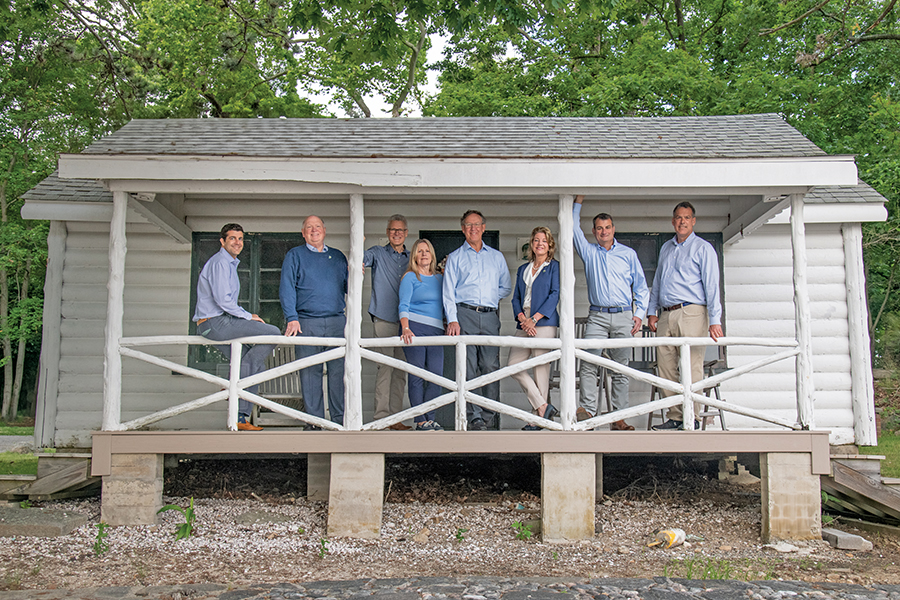
GIAC members at the beach cottage on Great Island, from left: Kipp Visi, Mike Burke, Jeff Taebel, Lori Bora, Dan Kolakowski, Monica McNally, Mark Adiletta, Bruce Ferguson. Missing: Jim Palen
“I very much appreciated RH’s enthusiasm from the beginning as well as their proximity to Darien and their experience with local projects and regulations,” said Dan Kolakowski.
As importantly, according to Monica, Reed Hilderbrand brings a keen sensitivity to the financial aspects of the project along with expertise in the range of ways we might pay for the plan we produce.
“I appreciated them being able to see the possibilities and incorporate the beauty and the ecological and preservation elements of the project,” said Monica, “but they also have the practical application, the ability to get the plan over the finish line,” she continued.
The request for public input is the beginning of Phase I of a four-phase plan. It also includes developing a Vision Plan.
“This initial stage with the information gathering and community input is the crucial first step to what will likely be a long development process,” said Mark Adiletta.
In Phase II, the Vision Plan will be turned into a Master Plan and Concept Design which will balance what the community wants with financial feasibility, including identifying funding sources such as grants, public-private partnerships, individual philanthropy and more, not just for any building and renovation we do but also to cover operation and maintenance costs. This, along with Phase I, is projected to take approximately a year, Monica estimates. Phase III and IV involve preparing to build then bidding and construction, with timing to be determined by the scope of work. Reed Hilderbrand will lead us through Phase I and II for a negotiated fee of $1,425,000 which includes $45k for contracting land use consultant Redniss & Mead to serve as a liaison between Reed Hilderbrand, GIAC and the Department of Public Works to ensure smooth communication and coordination. This appropriation was approved by the RTM at their June 17th meeting.
“Reed Hilderbrand has a deep bench with expertise in all of the different areas that will be needed to successfully develop the Master Plan,” commented Jim Palen. “In addition, they have proven experience working with committees such as GIAC to thoughtfully and efficiently gather and analyze public input to help our committee insure that we are developing a long-term plan that matches with that of our residents,” he added.
But before we can share what we want preserved, conserved, removed or re-imagined on Great Island, we must know what we have.
Owned by generations of Zieglers, beginning with William Ziegler, Sr., the baking soda magnate who bought Great Island in 1902 but died just three years later, and continuing with his son William Ziegler, Jr. who shaped much of what we find there today, then on to the generations that followed, Great Island arrives to us now, its past on nearly-untouched display:
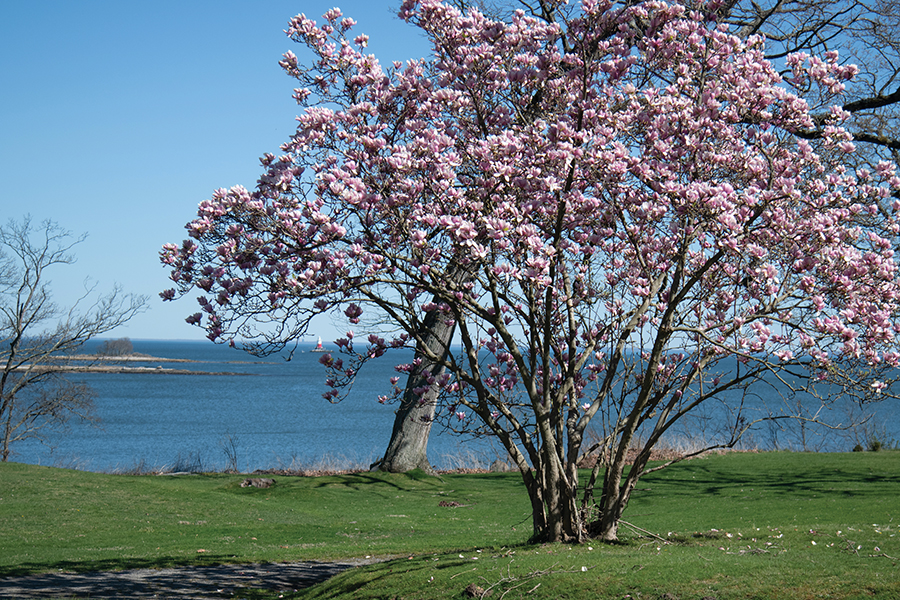
View of Green’s Ledge Light from Great Island
• The flora, fauna and original contours of meadows and woodlands, shoreline and outcroppings—as pristine in some places as they were centuries ago.
• A world class equestrian complex, including an 18-stall granite stable commissioned by William Ziegler, Jr., an avid polo player and owner of racehorses including Bounding Home, winner of the 1944 Belmont Stakes. Designed in 1913 by Rafael Guastavino, the stables feature his famous Tile Arch System, used also in Grand Central Terminal, Carnegie Hall and the U.S. Supreme Court building in Washington D.C., to name just a few of the iconic structures in which his work appears.
• The polo grounds, riding rings and 14 acres of trails – home, along with the stables, to now deceased Bill Steinkraus, a five-time Olympic show jumper who won a Gold Medal in 1968 in individual jumping. His wife, Helen (Sis),
a competitive dressage rider, was the daughter of William, Jr.
• A 39-room main house, one of America’s last family-owned Gilded Age mansions. It was built by William, Sr. in 1905. In 1927, William, Jr. remodeled it, hiring Addison Mizner—the best-known American architect in the 1920s widely credited with transforming Palm Beach—to do the work.
• Approximately a mile and a half of shoreline, including beaches, a beach cottage, bathhouses, a jetty – installed to create a swimming area even at low tide and also to protect the sand adjacent to it from erosion, a boat house and a yacht basin complete with deep water dock able to accommodate a 50-foot yacht (but home these past 35 years to Marine 34, the firefighting and rescue boat operated by the Noroton Fire Department)—all built by William, Jr., as was nearly every stone structure on the Island.
• The white marble statuary. Commissioned by William, Jr., Platonic Love was completed by sculptor John Gregory in 1936 and Romantic Love was completed by sculptor Mario Korbel in 1939. Currently valued at $425,000, the statues were gifted by Eric, Philip and Ned Steinkraus to Darien when they sold the property to the town.
• An original 19th century structure that pre-dates the Ziegler’s ownership by 100 years which is now part of a farm-house beside the stables; a caretaker’s house with an 86-foot long underground root cellar and a four-bedroom, three-bathroom house built in 1928 for the nanny of William, Jr.’s children.
• A carriage house with echoes of a turntable that allowed multiple carriages to be pulled indoors and parked on either side of it.
• A stone amphitheater of retaining walls built for soil stabilization and used as stairs to the main house.
• …and a squash court even, used now for storage.
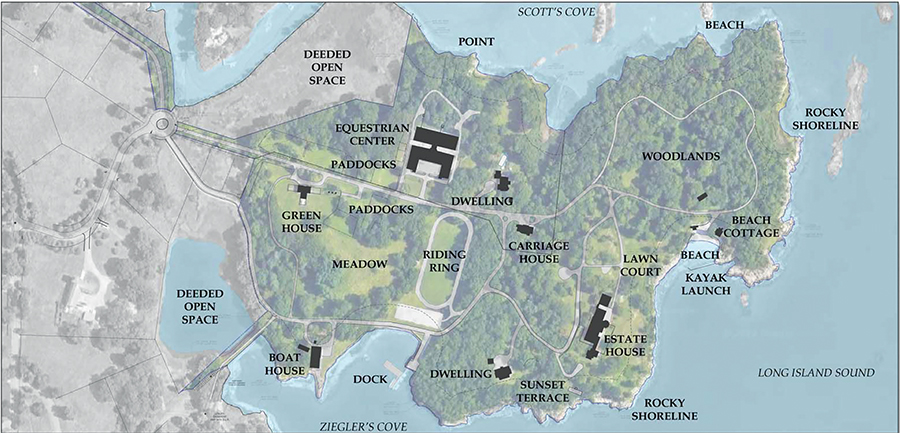
It’s a lot to take in, a lot to evaluate. The possibilities are mesmerizing. Visiting it feels a bit voyeuristic, the way it sometimes does when you first occupy a new home, until you make it your own which is what GIAC, with guidance from Reed Hilderbrand, is helping us do now.
“We are so fortunate in Darien to have the ability to recognize generational opportunities and seize them,” said Mike Burke. “The hands of town leaders and volunteers have brought us to this launch point. It will take all of us in Darien however to help Great Island realize its best future. So, participate.”
“I encourage everyone to visit Great Island and to take advantage of the opportunities for public input during the development of the Vision Plan,” agreed Jeff Taebel.
For more about Great Island, visit darienct.gov.


